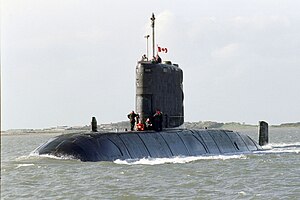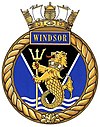
Back اچامسیاس ویندسور Persian HMCS Windsor (SSK 877) Finnish NCSM Windsor (SSK 877) French HMCS Windsor Malay
 Windsor underway
| |
| History | |
|---|---|
| Name | Unicorn |
| Builder | Cammell Laird, Birkenhead |
| Laid down | 13 March 1990 |
| Launched | 16 April 1992 |
| Commissioned | 25 June 1993 |
| Decommissioned | 16 October 1994 |
| Fate | Transferred to Canada 1998 |
| Name | Windsor |
| Acquired | 6 August 2001 |
| Commissioned | 4 October 2003[1][a] |
| Motto | “Silent Pride” |
| Status | in active service |
| Notes | Colours: Gold and Blue |
| Badge |  |
| General characteristics | |
| Class and type | Upholder/Victoria-class submarine |
| Displacement |
|
| Length | 70.26 m (230 ft 6 in) |
| Beam | 7.6 m (24 ft 11 in) |
| Draught | 5.5 m (18 ft 1 in) |
| Propulsion |
|
| Speed |
|
| Range | 10,000 nautical miles (19,000 km) at 12 knots (22 km/h) |
| Test depth | 200 m (660 ft) |
| Complement | 53 officers and crew |
| Armament |
|
HMCS Windsor is a long-range hunter-killer (SSK) submarine of the Royal Canadian Navy, the second submarine of the Victoria class. She is named after the city of Windsor, Ontario. Built for the Royal Navy as the Upholder-class submarine HMS Unicorn (pennant number S43) she was purchased by Canada when the United Kingdom decided to move to an all-nuclear power fleet.
- ^ "His Majesty's Canadian Submarine Windsor (SSK 877)". Government of Canada. 13 October 2022. Retrieved 16 November 2024.
- ^ "Volume 2: Volume 2, Part 1: Extant Commissioned Ships". Official Lineages. National Defence and the Canadian Forces. 7 July 2006. Archived from the original on 6 October 2014. Retrieved 1 October 2014.
Cite error: There are <ref group=lower-alpha> tags or {{efn}} templates on this page, but the references will not show without a {{reflist|group=lower-alpha}} template or {{notelist}} template (see the help page).